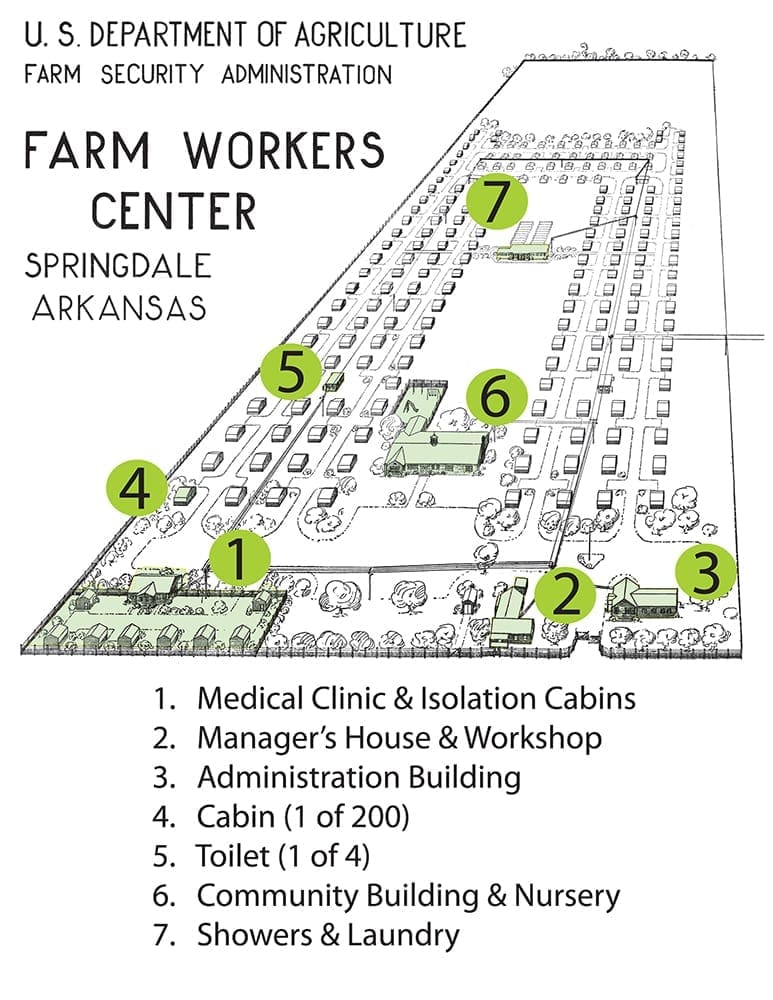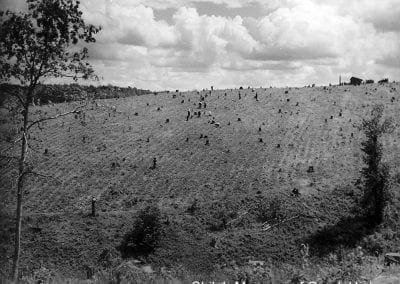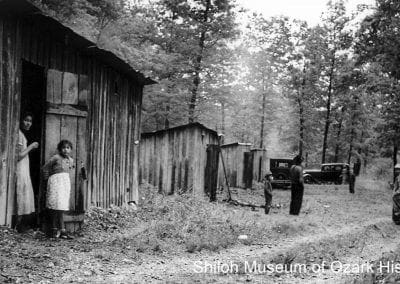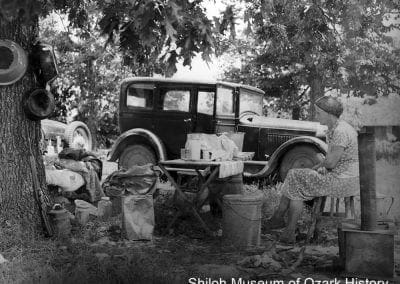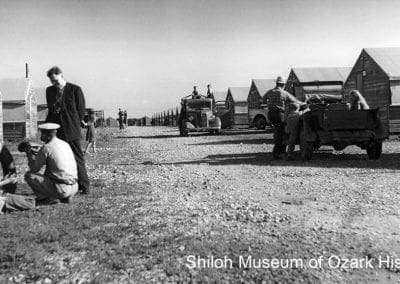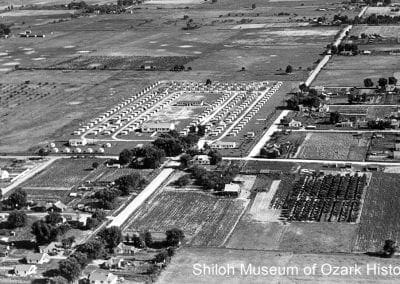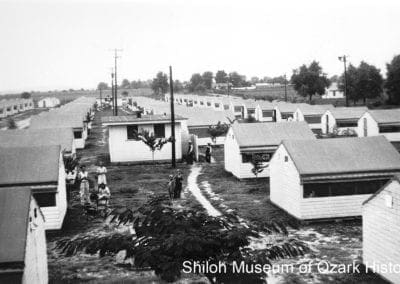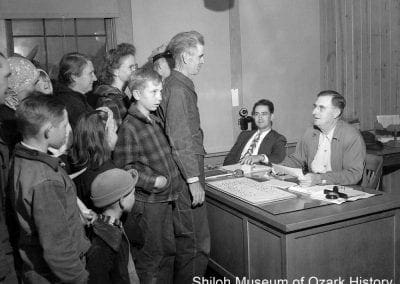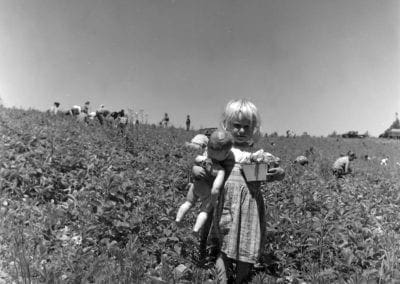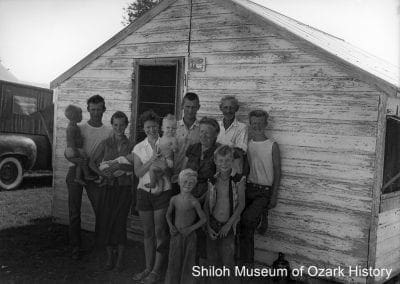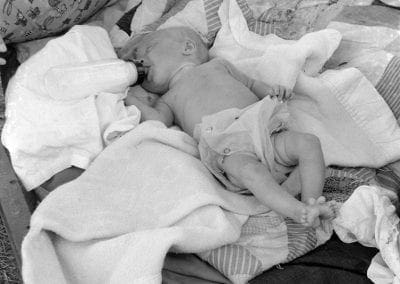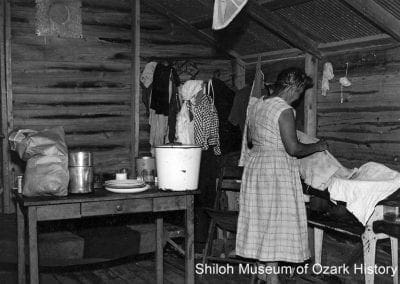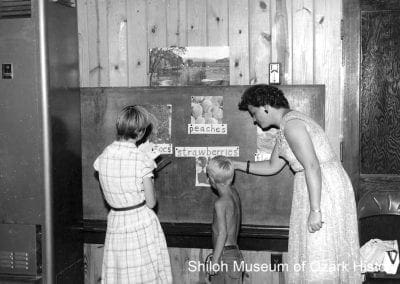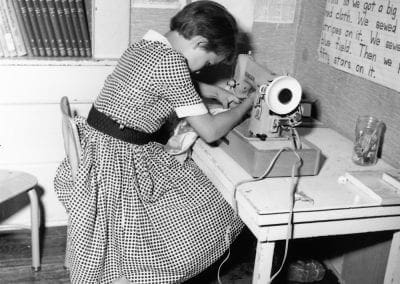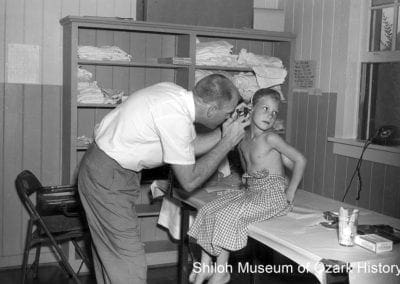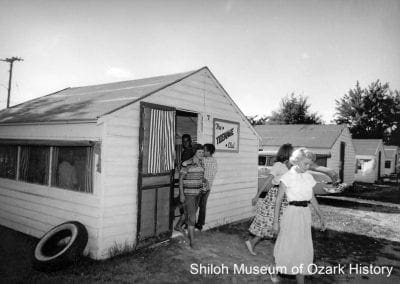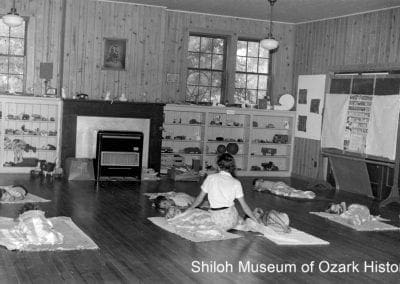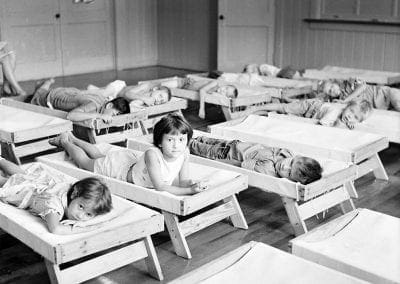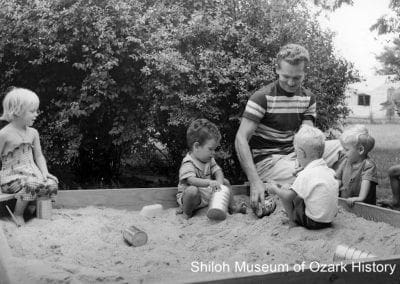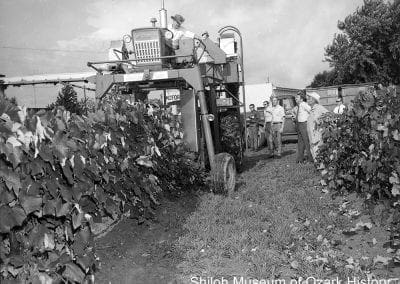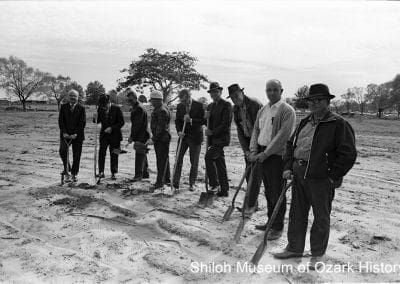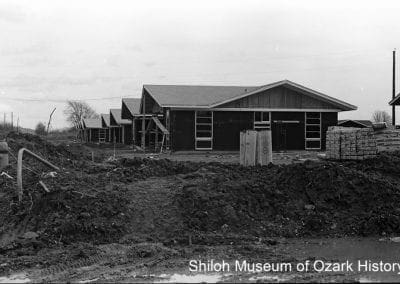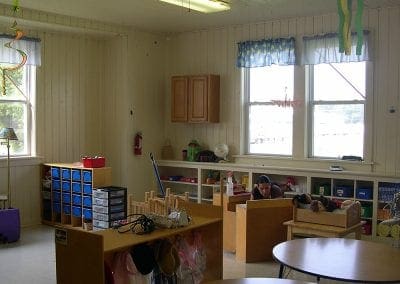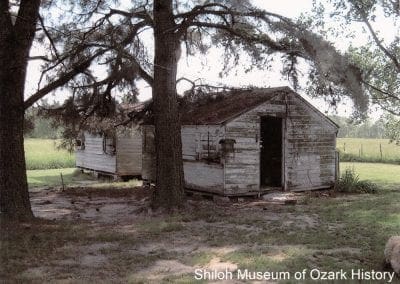Following the Crop
Online ExhibitAgriculture has long been a major economic force of Northwest Arkansas. Early pioneers grew crops to feed their families and livestock. With the arrival of the railroads in the late 1800s farmers grew additional produce and shipped it to market.
By the 1930s researchers had introduced new farming practices to improve crop yields. Commercial canning plants opened. More and more laborers were needed to pick and process the 24,000 acres of crops in Washington, Benton, and Madison Counties.
Financial hardship during the Great Depression led people across the nation to pack up their belongings in second-hand cars and “follow the crops,” traveling from town to town picking whatever crop was in season. In Northwest Arkansas strawberries were harvested first, followed by green beans, tomatoes, peaches, other berries, cherries, grapes, and apples. Entire families labored long hours in the fields. Those who were too young, too old, or too ill waited at the side of the field for the rest of the family to finish work.
Farmers couldn’t provide much in the way of good housing and medical care. Migrant laborers camped by their cars or lived on the farmer’s property in poultry houses or sheds. Host communities worried that folks without regular access to health care might bring diseases like tuberculosis to their area.
Agriculture has long been a major economic force of Northwest Arkansas. Early pioneers grew crops to feed their families and livestock. With the arrival of the railroads in the late 1800s farmers grew additional produce and shipped it to market.
By the 1930s researchers had introduced new farming practices to improve crop yields. Commercial canning plants opened. More and more laborers were needed to pick and process the 24,000 acres of crops in Washington, Benton, and Madison Counties.
Financial hardship during the Great Depression led people across the nation to pack up their belongings in second-hand cars and “follow the crops,” traveling from town to town picking whatever crop was in season. In Northwest Arkansas strawberries were harvested first, followed by green beans, tomatoes, peaches, other berries, cherries, grapes, and apples. Entire families labored long hours in the fields. Those who were too young, too old, or too ill waited at the side of the field for the rest of the family to finish work.
Farmers couldn’t provide much in the way of good housing and medical care. Migrant laborers camped by their cars or lived on the farmer’s property in poultry houses or sheds. Host communities worried that folks without regular access to health care might bring diseases like tuberculosis to their area.

Strawberry pickers, Springdale, May 1939. Dr. J. Lawrence Charlton, photographer. Dr. J. Lawrence Charlton Collection (S-86-15-14)
“[The pickers came earlier than expected] . . . they scared the cows and my Dad got flustered when we were not ready for them. We got the platform scales set up and leveled and Dad put the change into Mom’s muffin pan and we were in business. Dad paid two cents a pound for the picking. . . .”
Jeff Moser, who grew up on a farm in Cave Springs during the 1940s-50s
March 2008
“If you have ever seen migrant farm workers in the field in the past, you are certain to have noticed one thing: how hot, tired, neglected babies and small children have struggled out the weary day while their mothers assisted in the harvest of strawberries or beans.”
Billie Jines, columnist
Springdale News, 1960s
“The migrants were just like us, just hard-working people that got in the field about 5 a.m. and worked hard till about 1 p.m. . . . [They] would generally pick a few roasting ears from the corn to take home with them; Dad never said anything to them . . . as we had plenty.”
Jeff Moser, who grew up on a farm in Cave Springs during the 1940s-50s
March 2008
A Camp is Built
With the growing need for farm laborers, local business leaders and politicians wanted to provide good housing and health care to attract workers to the area. The Springdale Chamber of Commerce, working with U.S. Representative Clyde T. Ellis, approached the government for help.
In 1941 the U.S. Farm Security Administration agreed to place a migrant labor camp in Springdale. The $80,000, 40-acre camp would provide low-cost housing for the traveling farm workers who picked the crops or worked in the packing sheds and canning plants. The nearest labor camp was in Texas.
The camp was built in the southwest part of town, bounded by Caudle Avenue on the north and South Powell Street on the west. It had a community building, a medical clinic, a nursery, offices, a home for the camp’s manager, bathroom and laundry buildings, a playground and picnic area, and 200 wood cabins with canvas (later metal) roofs. Each 14-by-14-foot cabin could hold up to five people, for a total of 1,000 migrant workers.
The Farm Workers Shelter opened its doors on April 27, 1942. Organizers predicted that the camp would bring a “better class of labor.” The camp was open from April to November and included an on-site placement office to help workers find jobs.
Cabins could be rented for 10 cents a day or up to $2.50 a week, if the unit had electricity and a small kerosene stove. During the 1943 season 1,302 people (including 328 families) stayed at the camp; the average stay was 44 days.
The government ran the camp until 1948 when it was sold it to the City of Springdale. As part of the sale the City agreed to keep the camp open for the next 20 years.
“The purpose of the camp is to build community betterment; to rehabilitate the farm worker; to rebuild worn out bodies in the clinic; to refuel exhausted human machines by better food, housing and clothing; to rebuild confidence with self government and personal dignity; to look to a rejuvenated younger generation through education and training to conserve human ideals.”
A. D. Stewart, regional director, Farm Security Administration
Springdale News, April 30, 1942
“I remember that the labor camp was always clean and neat and was always kept up and the people were friendly and they went a long way to helping the farmers of the area as they could not have made it without them.”
Jeff Moser, who grew up on a farm in Cave Springs during the 1940s-50s
March 2008
“The place has a fence around it and they turn out the lights at 9 p.m.; this makes me feel like a prisoner.”
17-year-old Texas migrant worker
Springdale News, 1960s
“About 75 percent of the people in the labor camp are residents of Arkansas. There are no Mexicans or Negroes and these types of workers are not encouraged to come here.”
Springdale News, 1960s
A Camp is Built
With the growing need for farm laborers, local business leaders and politicians wanted to provide good housing and health care to attract workers to the area. The Springdale Chamber of Commerce, working with U.S. Representative Clyde T. Ellis, approached the government for help.
In 1941 the U.S. Farm Security Administration agreed to place a migrant labor camp in Springdale. The $80,000, 40-acre camp would provide low-cost housing for the traveling farm workers who picked the crops or worked in the packing sheds and canning plants. The nearest labor camp was in Texas.
The camp was built in the southwest part of town, bounded by Caudle Avenue on the north and South Powell Street on the west. It had a community building, a medical clinic, a nursery, offices, a home for the camp’s manager, bathroom and laundry buildings, a playground and picnic area, and 200 wood cabins with canvas (later metal) roofs. Each 14-by-14-foot cabin could hold up to five people, for a total of 1,000 migrant workers.
The Farm Workers Shelter opened its doors on April 27, 1942. Organizers predicted that the camp would bring a “better class of labor.” The camp was open from April to November and included an on-site placement office to help workers find jobs.
Cabins could be rented for 10 cents a day or up to $2.50 a week, if the unit had electricity and a small kerosene stove. During the 1943 season 1,302 people (including 328 families) stayed at the camp; the average stay was 44 days.
The government ran the camp until 1948 when it was sold it to the City of Springdale. As part of the sale the City agreed to keep the camp open for the next 20 years.
“The purpose of the camp is to build community betterment; to rehabilitate the farm worker; to rebuild worn out bodies in the clinic; to refuel exhausted human machines by better food, housing and clothing; to rebuild confidence with self government and personal dignity; to look to a rejuvenated younger generation through education and training to conserve human ideals.”
A. D. Stewart, regional director, Farm Security Administration
Springdale News, April 30, 1942
“I remember that the labor camp was always clean and neat and was always kept up and the people were friendly and they went a long way to helping the farmers of the area as they could not have made it without them.”
Jeff Moser, who grew up on a farm in Cave Springs during the 1940s-50s
March 2008
“The place has a fence around it and they turn out the lights at 9 p.m.; this makes me feel like a prisoner.”
17-year-old Texas migrant worker
Springdale News, 1960s
“About 75 percent of the people in the labor camp are residents of Arkansas. There are no Mexicans or Negroes and these types of workers are not encouraged to come here.”
Springdale News, 1960s
The Workers
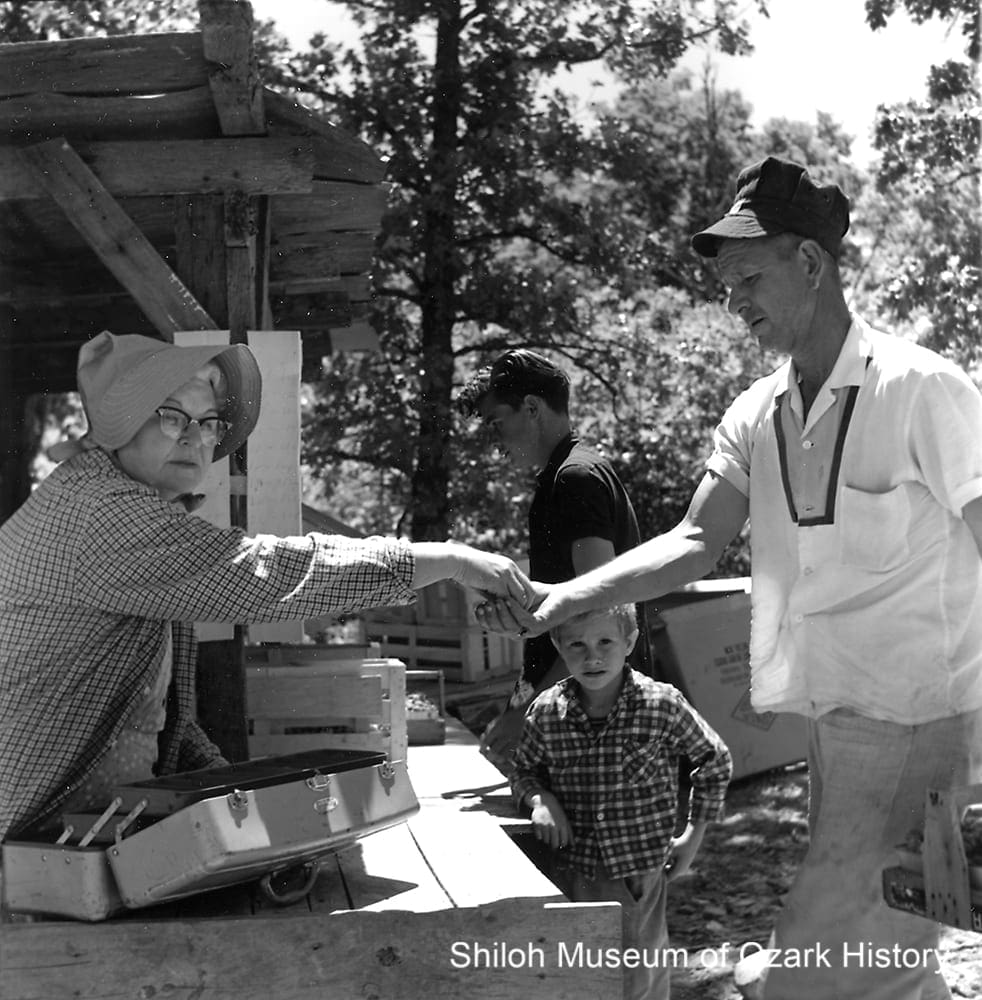
Paying strawberry pickers on the Kendle Sigmon farm, Springdale, June 1960. Howard Clark, photographer. Caroline Price Clark Collection (S-2002-72-1129)
At dawn farmers picked up their workers—from young children to elderly grandparents—and delivered them to the fields or packing sheds where they labored long, hot hours. Early afternoon saw the workers back at camp, cooking, cleaning, and resting.
Their cabins were tiny. Some were without gas or electricity; none had plumbing so water was fetched from pumps. Toilet, bathing, and laundry facilities were centralized and shared by many.
Following the crop took its toll on laborers and their families. Because they were constantly on the move, children missed school and fell behind in their grade levels. Field work didn’t pay much. Many families scraped by, relying on donations of food, clothing, and medical care. Health problems for some folks came about because they didn’t realize the importance of, or have access to, good nutrition and cleanliness.
Most people were glad to see the laborers return each year. Farmers needed their crops harvested. Merchants had goods and services for sale. Churches wanted to minister to the needy. However, as welcome as the laborers were, there often was an economic, class, and educational gulf between them and the local community.
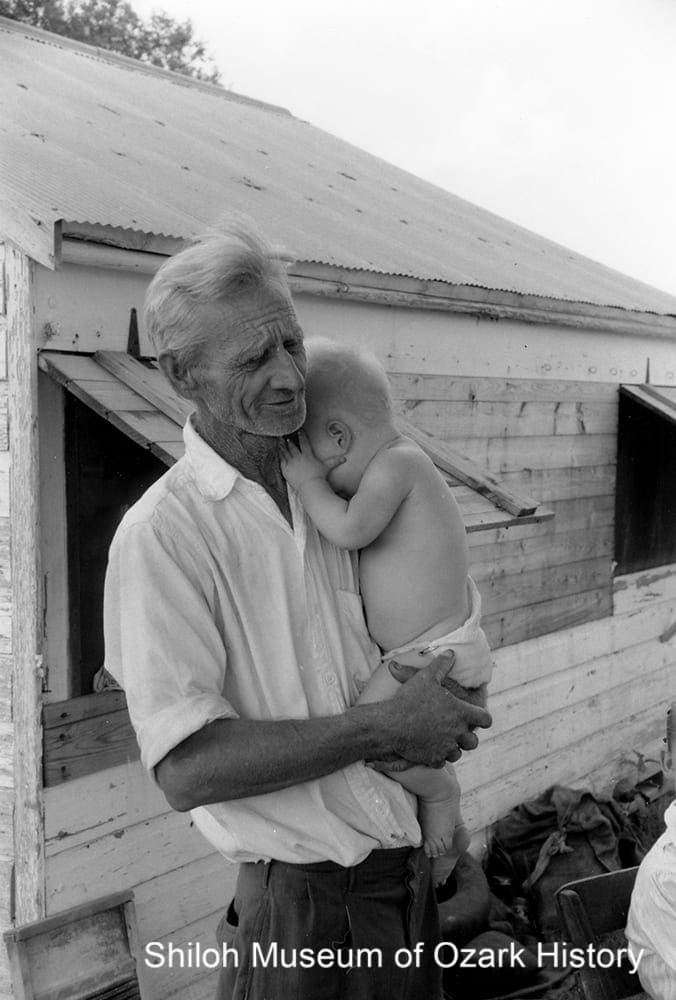
Omer Bynum with his granddaughter Rhonda Walton, 1957. Howard Clark, photographer. Caroline Price Clark Collection (S-2001-82-327)
“As volunteers rock babies in the nursery or play with older children, the question each one asks is—What will become of this child? Must he, too, be a migrant? If so, must he live under these same unsanitary, crowded conditions and face the same insecurities and the same isolation from school, church and community?”
Cassandra Stockburger, state director
Division of Home Missions, National Council of Churches, 1957
“[A teacher] . . . related one child telling that her mother had sold her wedding rings to buy medicine for their baby. She also said children telling of one of their parents leaving home was not unusual.”
Ruth Ann Snipes, journalist
Springdale News, August 6, 1965
“There never is much time for food for breakfast: a piece of bacon and white gravy poured over heavy skillet-fried biscuits or pieces of loaf bread.…Babies are fed hurriedly from the mother’s plate and then, if lucky, are given a bottle of canned milk to drink on the way to the field where big sister, age three or four, will mind them at the edge of the field. . . .”
Cassandra Stockburger, state director
Division of Home Missions, National Council of Churches, 1957
The Workers

Paying strawberry pickers on the Kendle Sigmon farm, Springdale, June 1960. Howard Clark, photographer. Caroline Price Clark Collection (S-2002-72-1129)
At dawn farmers picked up their workers—from young children to elderly grandparents—and delivered them to the fields or packing sheds where they labored long, hot hours. Early afternoon saw the workers back at camp, cooking, cleaning, and resting.
Their cabins were tiny. Some were without gas or electricity; none had plumbing so water was fetched from pumps. Toilet, bathing, and laundry facilities were centralized and shared by many.
Following the crop took its toll on laborers and their families. Because they were constantly on the move, children missed school and fell behind in their grade levels. Field work didn’t pay much. Many families scraped by, relying on donations of food, clothing, and medical care. Health problems for some folks came about because they didn’t realize the importance of, or have access to, good nutrition and cleanliness.
Most people were glad to see the laborers return each year. Farmers needed their crops harvested. Merchants had goods and services for sale. Churches wanted to minister to the needy. However, as welcome as the laborers were, there often was an economic, class, and educational gulf between them and the local community.

Omer Bynum with his granddaughter Rhonda Walton, 1957. Howard Clark, photographer. Caroline Price Clark Collection (S-2001-82-327)
“As volunteers rock babies in the nursery or play with older children, the question each one asks is—What will become of this child? Must he, too, be a migrant? If so, must he live under these same unsanitary, crowded conditions and face the same insecurities and the same isolation from school, church and community?”
Cassandra Stockburger, state director
Division of Home Missions, National Council of Churches, 1957
“[A teacher] . . . related one child telling that her mother had sold her wedding rings to buy medicine for their baby. She also said children telling of one of their parents leaving home was not unusual.”
Ruth Ann Snipes, journalist
Springdale News, August 6, 1965
“There never is much time for food for breakfast: a piece of bacon and white gravy poured over heavy skillet-fried biscuits or pieces of loaf bread.…Babies are fed hurriedly from the mother’s plate and then, if lucky, are given a bottle of canned milk to drink on the way to the field where big sister, age three or four, will mind them at the edge of the field. . . .”
Cassandra Stockburger, state director
Division of Home Missions, National Council of Churches, 1957
Lending a Hand
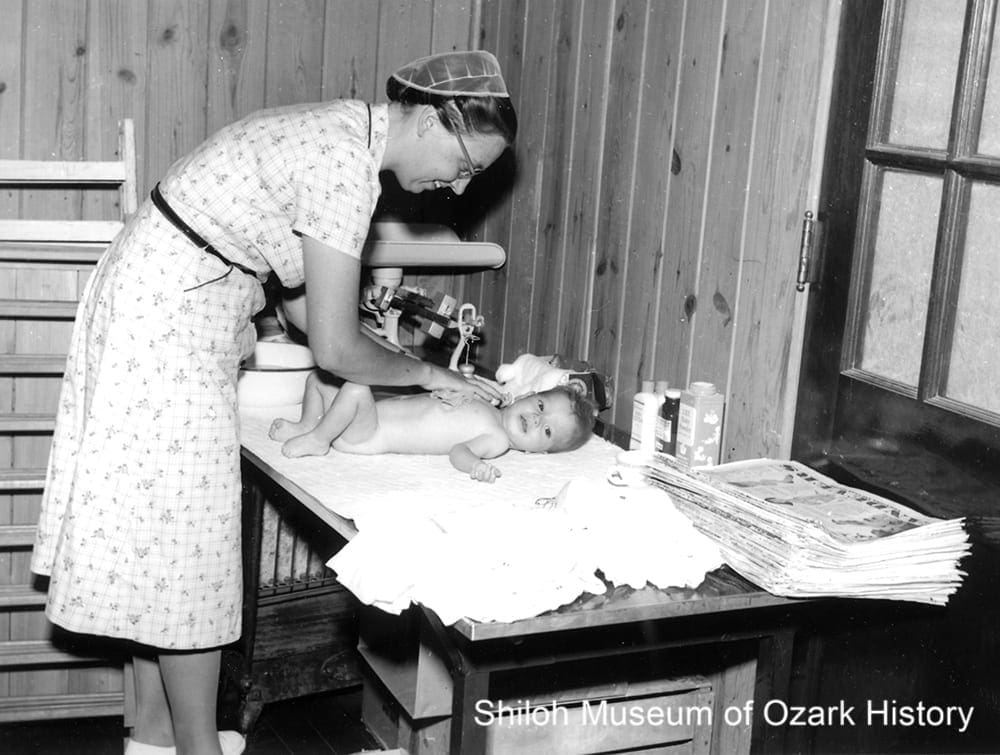
Mennonite volunteer, 1958. Howard Clark, photographer. Caroline Price Clark Collection (S-2002-72-1900)
There were many civic, business, and religious organizations which helped meet the needs of the migrant laborers over the years. Among those lending a hand were the Springdale Chamber of Commerce, the non-denominational Home Missions Council of North America, the Home Mission Service of the Baptist Church, the United Church Women of Springdale, the Voluntary Service Team of the Mennonite Central Committee, the Office of Economic Opportunity, the Washington County Health Department, and the Northwest Arkansas Area Migrant Committee.
A variety of aid programs were offered over the years. Volunteers and paid staff provided health care, nursery programs, education, recreation, relief, and religious services. There were adult literacy classes, Sunday School, and educational classes for children. A mothers’ club allowed women to socialize and make handicrafts such as rag dolls. Area dentists treated patients and taught proper tooth care. Doctors and public health nurses gave immunization shots and treated illnesses.
Children took field trips to the library, the fire department, and the swimming pool. They played board games, horseshoes, and volleyball and learned skills like sewing and woodworking. A teenage club was set up in one cabin while a church operated a clothing supply center in another.
The nursery school featured child-sized furniture, drinking fountains, and toilets. Plenty of nutritious food and nap times were offered to help the children gain weight and lose chronic colds.
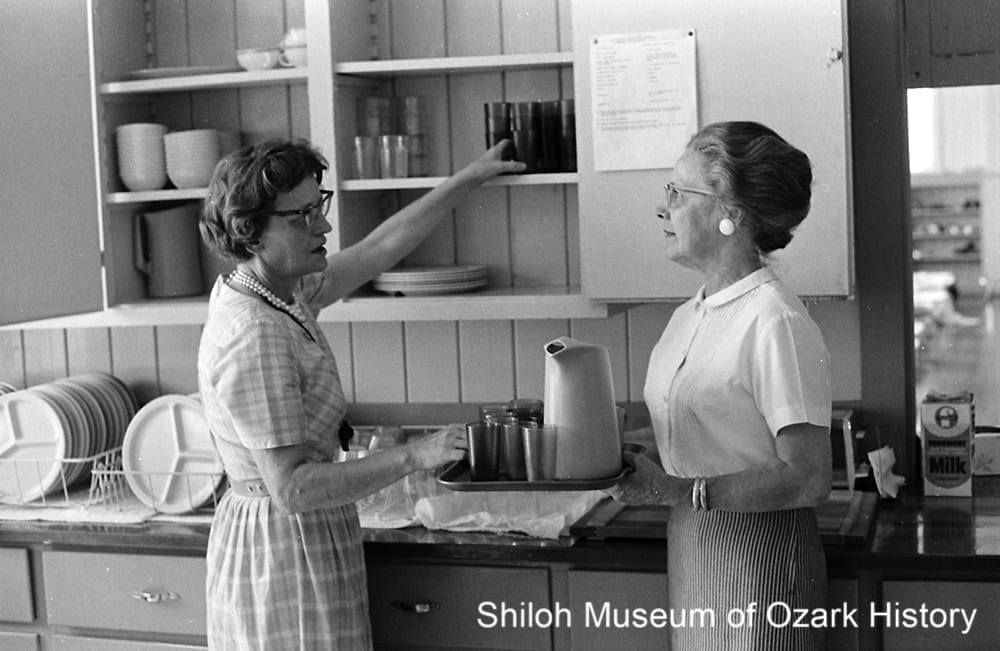
Serving afternoon snacks at the Day Care Center, July 6, 1966. Luella Hayes (left) and Ima Jean Lindstrom. Charles Bickford, photographer. Springdale News Collection (SN 7-6-1966)
“Though they live here and work here, some for extended periods, we do not know them and they do not know us. This project is designed to break down those barriers between us and to aid, if we can, in making their stay with us a pleasant and profitable one.”
Eva Reder, president, United Church Women of Springdale
Springdale News, circa 1957
“Oh goody, we have something somebody didn’t give us!”
Young migrant girl learning to sew a blouse and skirt
Springdale News, May 5, 1967
“We usually try to spend about three evenings each week in the camp playing baseball, drawing, painting, square dancing, and other children’s activities.”
Young labor camp volunteer, circa 1957
“In the normal classroom they are the low achievers, the failures, and they know it. We are trying to give each of them the chance to succeed at something this summer, to get the feeling of having done something well. Once this happens, they have something to build another success upon.”
Mike Zotti, deputy superintendent of curriculum and special services, Springdale Public Schools
Arkansas Gazette, August 6, 1967
Lending a Hand

Mennonite volunteer, 1958. Howard Clark, photographer. Caroline Price Clark Collection (S-2002-72-1900)
There were many civic, business, and religious organizations which helped meet the needs of the migrant laborers over the years. Among those lending a hand were the Springdale Chamber of Commerce, the non-denominational Home Missions Council of North America, the Home Mission Service of the Baptist Church, the United Church Women of Springdale, the Voluntary Service Team of the Mennonite Central Committee, the Office of Economic Opportunity, the Washington County Health Department, and the Northwest Arkansas Area Migrant Committee.
A variety of aid programs were offered over the years. Volunteers and paid staff provided health care, nursery programs, education, recreation, relief, and religious services. There were adult literacy classes, Sunday School, and educational classes for children. A mothers’ club allowed women to socialize and make handicrafts such as rag dolls. Area dentists treated patients and taught proper tooth care. Doctors and public health nurses gave immunization shots and treated illnesses.
Children took field trips to the library, the fire department, and the swimming pool. They played board games, horseshoes, and volleyball and learned skills like sewing and woodworking. A teenage club was set up in one cabin while a church operated a clothing supply center in another.
The nursery school featured child-sized furniture, drinking fountains, and toilets. Plenty of nutritious food and nap times were offered to help the children gain weight and lose chronic colds.

Serving afternoon snacks at the Day Care Center, July 6, 1966. Luella Hayes (left) and Ima Jean Lindstrom. Charles Bickford, photographer. Springdale News Collection (SN 7-6-1966)
“Though they live here and work here, some for extended periods, we do not know them and they do not know us. This project is designed to break down those barriers between us and to aid, if we can, in making their stay with us a pleasant and profitable one.”
Eva Reder, president, United Church Women of Springdale
Springdale News, circa 1957
“Oh goody, we have something somebody didn’t give us!”
Young migrant girl learning to sew a blouse and skirt
Springdale News, May 5, 1967
“We usually try to spend about three evenings each week in the camp playing baseball, drawing, painting, square dancing, and other children’s activities.”
Young labor camp volunteer, circa 1957
“In the normal classroom they are the low achievers, the failures, and they know it. We are trying to give each of them the chance to succeed at something this summer, to get the feeling of having done something well. Once this happens, they have something to build another success upon.”
Mike Zotti, deputy superintendent of curriculum and special services, Springdale Public Schools
Arkansas Gazette, August 6, 1967
Closing the Camp
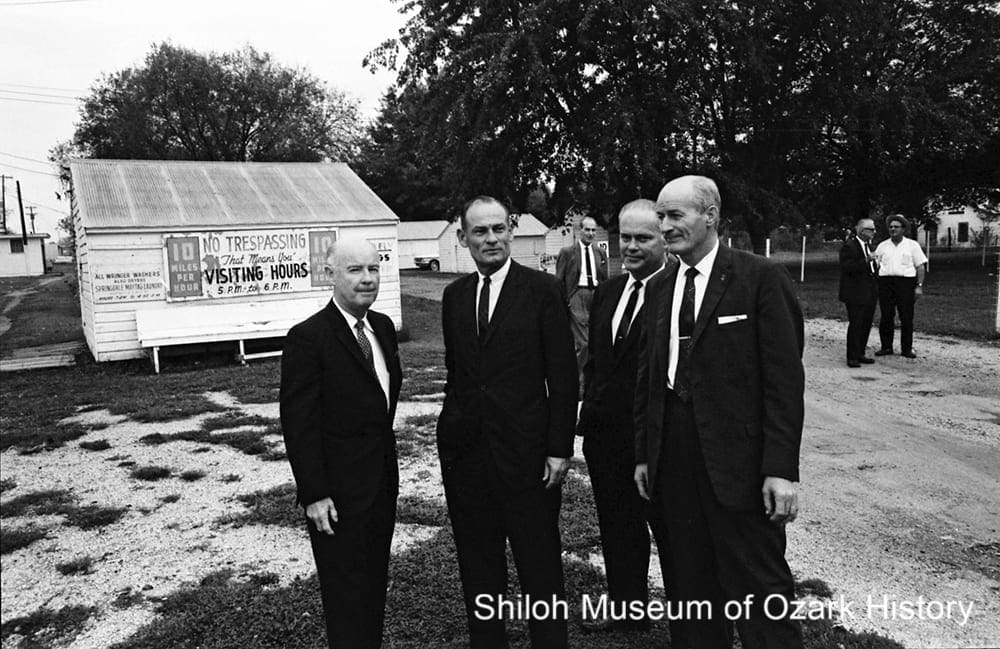
Arkansas Employment Security Division officials visiting the labor camp, September 8, 1967. Charles Bickford, photographer. Springdale News Collection (SN 9-1967-21)
The number of laborers staying at the camp rose and fell over the summers and through the years. Bumper crops might bring many workers, but crop failures or a slow-down in jobs forced families to move down the road to the next opportunity. By the 1960s a new threat was on the horizon—automated bean pickers. Increased mechanization meant that some crops could be picked more cheaply and effectively by machines than by people. Camp attendance began to drop.
When the City of Springdale received the camp from the federal government it promised to run it for 20 years. In July 1968 the decision was made to close the camp at the end of the summer and sell the remaining 160 cabins, only 40 of which were still occupied.
Rather than running a labor camp, the Springdale Housing Authority wanted to build a 170-unit low-income housing development on the camp’s land, using federal funds to secure the 40-year loan. Groundbreaking on Phillips Plaza, named after Springdale’s mayor, Park Phillips, began in the fall of 1969. By May 1971 the first renters were living in the $2-million-dollar project.
Today much of the camp exists only in memories and photographs. A few of the old cabins may still stand as outbuildings in area yards and fields. The camp’s old community building, which once held the nursery school for migrant children, was moved to the southern part of the property. It serves as a Head Start school, continuing the structure’s long tradition of sheltering youngsters in need.
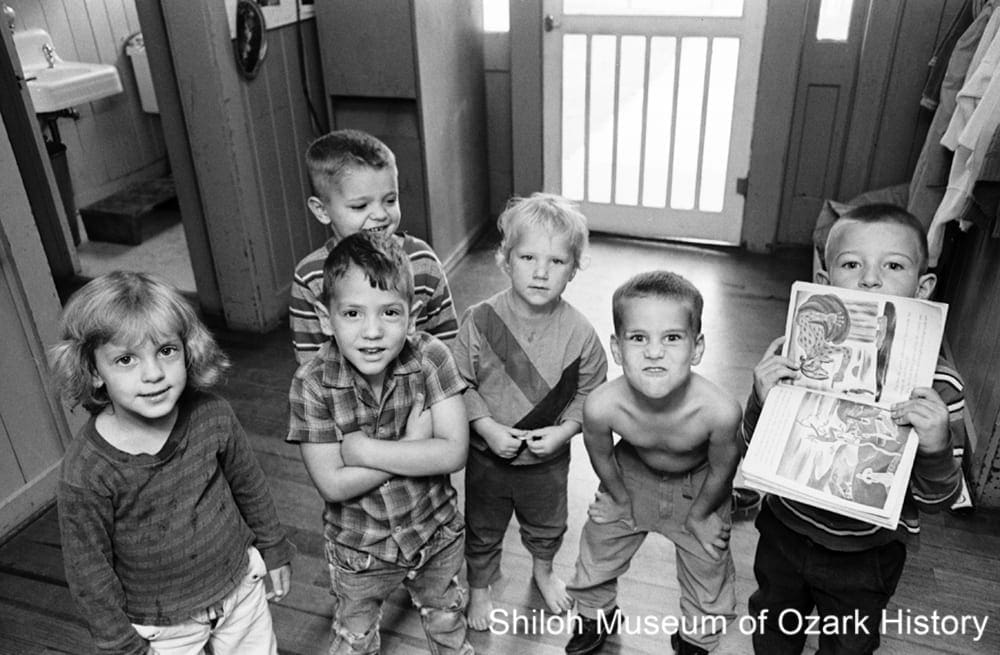
Children at the day care center, September 19, 1967. Charles Bickford, photographer. Springdale News Collection (SN 9-1967-3)
“[The migrant ministry workers] . . . wonder if the scarcity of migrant workers at the Labor Center this year may mean that the workers are beginning to settle into permanent locations. . . .They only know that approximately 90 per cent of the 3,000 acres of beans in this area are being picked by machine this year. And they just don’t offer a ministry program to machines.”
Billie Jines, columnist
Springdale News, July 8, 1963
“[The Housing Authority units would] . . . relieve some of the pressure for local housing needs, especially for the lower income folks, and provide adequate living conditions when in some cases the housing has been substandard.”
Charles Sanders, editor and columnist
Springdale News, October 16, 1969
“We picked green beans, tomatoes, strawberries . . . it was hard . . . I got too hot sometimes. . . .There was times it was really good, we’d come home from picking beans and go get some ice cream [on Emma Avenue]. [The camp was] …okay. We were satisfied that we had food to eat and a roof over our heads. . . . It was an adventure for us kids.”
Glenda Emery Wright, who was 13 years old when she lived in the camp in 1946
April 2008
Closing the Camp

Arkansas Employment Security Division officials visiting the labor camp, September 8, 1967. Charles Bickford, photographer. Springdale News Collection (SN 9-1967-21)
The number of laborers staying at the camp rose and fell over the summers and through the years. Bumper crops might bring many workers, but crop failures or a slow-down in jobs forced families to move down the road to the next opportunity. By the 1960s a new threat was on the horizon—automated bean pickers. Increased mechanization meant that some crops could be picked more cheaply and effectively by machines than by people. Camp attendance began to drop.
When the City of Springdale received the camp from the federal government it promised to run it for 20 years. In July 1968 the decision was made to close the camp at the end of the summer and sell the remaining 160 cabins, only 40 of which were still occupied.
Rather than running a labor camp, the Springdale Housing Authority wanted to build a 170-unit low-income housing development on the camp’s land, using federal funds to secure the 40-year loan. Groundbreaking on Phillips Plaza, named after Springdale’s mayor, Park Phillips, began in the fall of 1969. By May 1971 the first renters were living in the $2-million-dollar project.
Today much of the camp exists only in memories and photographs. A few of the old cabins may still stand as outbuildings in area yards and fields. The camp’s old community building, which once held the nursery school for migrant children, was moved to the southern part of the property. It serves as a Head Start school, continuing the structure’s long tradition of sheltering youngsters in need.

Children at the day care center, September 19, 1967. Charles Bickford, photographer. Springdale News Collection (SN 9-1967-3)
“[The migrant ministry workers] . . . wonder if the scarcity of migrant workers at the Labor Center this year may mean that the workers are beginning to settle into permanent locations. . . .They only know that approximately 90 per cent of the 3,000 acres of beans in this area are being picked by machine this year. And they just don’t offer a ministry program to machines.”
Billie Jines, columnist
Springdale News, July 8, 1963
“[The Housing Authority units would] . . . relieve some of the pressure for local housing needs, especially for the lower income folks, and provide adequate living conditions when in some cases the housing has been substandard.”
Charles Sanders, editor and columnist
Springdale News, October 16, 1969
“We picked green beans, tomatoes, strawberries . . . it was hard . . . I got too hot sometimes. . . .There was times it was really good, we’d come home from picking beans and go get some ice cream [on Emma Avenue]. [The camp was] …okay. We were satisfied that we had food to eat and a roof over our heads. . . . It was an adventure for us kids.”
Glenda Emery Wright, who was 13 years old when she lived in the camp in 1946
April 2008
Photo Gallery
86-15-5
Picking strawberries, Springdale area, 1939. Dr. J. Lawrence Charlton, photographer. Dr. J. Lawrence Charlton Collection (S-86-15-5)
86-15-7
Native American strawberry pickers (probably Cherokee) in farm shelters, Springdale area, 1939. Dr. J. Lawrence Charlton, photographer. Dr. J. Lawrence Charlton Collection (S-86-15-7)
86-15-13
Migrant camp, Springdale area, 1939. Dr. J. Lawrence Charlton, photographer. Dr. J. Lawrence Charlton Collection (S-86-15-13)
86-15-21
Labor camp, Springdale, August 1942. Dr. J. Lawrence Charlton, photographer. Dr. J. Lawrence Charlton Collection (S-86-15-21)
2002-72-348
Aerial view of labor camp, southeast Springdale, 1944. Howard Clark, photographer. Caroline Price Clark Collection (S-2002-72-348)
2004-35-1
Cabins surrounding one of four toilet facilities, Springdale, about 1945. Ray Tripp Collection (S-2004-35-1)
77-9-262
Labor camp office, Springdale, mid 1940s. Denver Misenhimer, director, at desk. Springdale Chamber of Commerce Collection (S-77-9-262)
2002-72-1132
Strawberry pickers, Springdale area, June 1960. Howard Clark, photographer. Caroline Price Clark Collection (S-2002-72-1132)
2002-72-953
Omer Bynum family, Springdale, August 1957. Front, from left: Dale Bynum, Lonnie Bynum, Beverly Bynum, Helen Bynum, Nina Faye Bynum Walton, Rhonda Walton, Mickey Bynum (shirtless), Frances Lee Bynum, and Larry Bynum (open shirt). Against wall, from left: Homer Walton, Omer Bynum, and Sammy Bynum. Howard Clark, photographer. Caroline Price Clark Collection (S-2002-72-953)
2001-82-326
Helen Bynum, Springdale, August 1957. Howard Clark, photographer. Caroline Price Clark Collection (S-2001-22-326)
2002-72-955
Frances Lee Bynum in her cabin, Springdale, August 1957. Howard Clark, photographer. Caroline Price Clark Collection (S-2002-72-955)
2002-72-979
Teacher and children, Springdale, August 1957. From left: Sherry Bynum, Mickey Bynum, and Cassandra Stockburger. Howard Clark, photographer. Caroline Price Clark Collection (S-2002-72-979)
2002-72-1885
Child sewing a piece of clothing, Springdale, August 1960. Howard Clark, photographer. Caroline Price Clark Collection (S-2002-72-1885)
2002-72-1914
Dr. Joe Parker examining a young girl, Springdale, August 1961. Howard Clark, photographer. Caroline Price Clark Collection (S-2002-72-1914)
2002-72-978
The Teenage Club, Springdale, August 1957. Howard Clark, photographer. Caroline Price Clark Collection (S-2002-72-978)
2002-72-1901
Naptime, Springdale, 1958. Howard Clark, photographer. Caroline Price Clark Collection (S-2002-72-1901)
SN8-3-65-4
Naptime, Springdale, August 3, 1965. Charles Bickford, photographer. Springdale News Collection (SN 8-3-1965)
2002-72-1909
Aid worker with children, Springdale, 1958. Howard Clark, photographer. Caroline Price Clark Collection (S-2002-72-1909)
85-325-4158
Grape harvester demonstration, Welch Grape Juice Company, Springdale, September 1970. Ray Watson, photographer. Ray Watson Collection (S-85-325-4158)
SN10-1969-24
Ground breaking for Phillips Plaza, a low-rent housing development built on labor camp property, Springdale, October 16, 1969. From left: Dr. Stanley Applegate, Mayor Park Phillips, Phil Phillips, Art Smith, Charles Sanders, Frank O’Donnel, Joe Bunn, unidentified, and unidentified. Jim Morriss, photographer. Springdale News Collection (SN 10-1969-24)
SN3-1970-9
Houses under construction, Phillips Plaza, Springdale, March 2, 1970. Charles Bickford, photographer. Springdale News Collection (SN 3-1970-9)
modern
A Head Start classroom in the old labor camp community building, Springdale, August 2007. Shiloh Museum of Ozark History
Credits
“Church Women Hear Facts on Local Schools.” Springdale News, May 3, 1957.
“City Obtains Migrant Labor Camp in 1948.” Springdale News, November 30, 1962.
City of Springdale, Arkansas. Ordinance No. 310: An Ordinance Governing the Migratory Labor Center of the City of Springdale, Arkansas.
“City to Open Labor Center.” Springdale News, April 15, 1948.
Clark, Caroline. “Camp for Migrant Workers.” Oklahoma Ranch and Farm World, May 10, 1959.
Clark, Caroline. “Migrant Farm Workers.” Arkansas Gazette, October 13, 1957.
Collins, Anna Schwegler. Conversation or email correspondence. April 14, 2008.
“Construction Work on Labor Center Started.” Springdale News, July 10, 1941.
Deane, Ernie. “A Real Helping Hand for Little ‘Nomads.’” Arkansas Gazette, July 16, 1961.
Dozier, Kathleen. “Coordinated Effort, Sleeping Children Greet Guests at Center.” Springdale News, July 11,1966.
Edgmon, Jim. “Labor Camp Operation Explained.” Springdale News, 1960s.
“Farm Labor Camp Probably Located on Park Avenue.” Springdale News, March 13, 1941.
“Farm Labor Center Has Biggest Year.” Springdale News, November 21, 1946.
“Farm Products Bring Dollars, Labor Shortage Relieved by Center.” Springdale News, December 3, 1942.
“Farm Workers Shelter is Dedicated Saturday by FSA Officials.” Springdale News, April 30, 1942.
“FSA Investigating Migratory Labor Problem.” Springdale News, February 13, 1941.
Henry, Earlene Brown. Conversation or email correspondence. March 13, 2008.
“Housing Authority to Get Appraisal for Labor Center Property.” Springdale News, December 3, 1968.
Jines, Billie. “The Way I Heard It.” Springdale News, August 9, 1960; July 8, 1963.
Jones, Mary John. Conversation or email correspondence. April 14, 2008.
“Labor Camp Dedication Saturday; Ready for Works Monday.” Springdale News, April 23, 1942.
“Labor Camp is Now Open; 100 are Registered.” Springdale News, March 13, 1949.
“Labor Camp Offered for Sale.” Springdale News, December 18, 1947.
“Labor Camp Registered 1,302 People.” Springdale News, October 21,1943.
Lankford, Martha Reder. Conversation or email correspondence. March 17, 2008.
Northwest Arkansas Area Migrant Committee Project (MG-50D67), Washington and Benton Counties. “Migrant Health Project Annual Report.” 1966-67.
“Migrant Labor Center to be Auctioned Into Oblivion.” Springdale News, July 24, 1968.
Migrant Ministry Committee of the United Council of Church Women of Springdale, Arkansas. “Statement on a Ministry to Migrants.” Circa 1957.
“Migratory Farm Labor Camp Here Certain.” Springdale News, May 15, 1941.
Minutes of the Northwest Arkansas Area Migrant Committee and the Migrant Ministry Committee of the Arkansas Council of Churches. Springdale, May 18,1964 (S-94-157).
Moser, Jeff Moser. Conversation or email correspondence. May 2008.
Murphey, Sara. “A Note on a Different Type of ‘Labor Camp.’” Arkansas Gazette, August 6, 1967.
Northwest Arkansas Area Migrant Committee Project, Washington and Benton Counties. “Annual Report, Migrant Health Project.” 1963-64.
“Nursery School Opens at Farm Labor Center.” Springdale News, May 23, 1946.
Report by an unknown camp counselor, circa 1957 (Shiloh Museum manuscript MS #42 5-6A).
Smith, Guy P. Jr. “Springdale Labor Camp.” 1990s.
Snipes, Ruth Ann. “Migrant Assistance Grows in Scope, Annual Dinner Slated to Aid Programs.” Springdale News, May 5,1967.
Snipes, Ruth Ann. “Migrant Ministry Aided.” Springdale News, September 28, 1967.
Snipes, Ruth Ann. “United Church Women Help Migrant Children Keep Up In School.” Springdale News, August 6,1965.
Stockburger, Cassandra. Letter to Maxine Bowman. Division of Home Missions, National Council of the Churches of Christ, February 8, 1957 (S-92-132-6:3 A-B).
Stockburger, Cassandra. “Springdale Finds an Answer.” Migrant Ministry, Division of Home Missions, National Council of Churches, circa 1957.
Tripp, Ray. Conversation or email correspondence. March 28, 2008.
Wilson, Mary Emery, and Glenda Emery Wright. Conversation or email correspondence. April 16, 2008.
Young, Susan. “Migrant Camp Remembered.” Northwest Arkansas Morning News, May 18, 2004.


